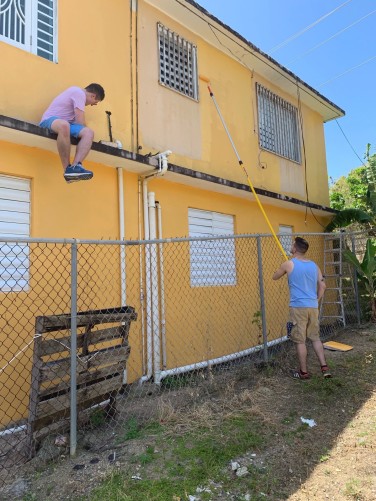By Heather Cass, Publications Manager, Penn State Behrend

What do a dog’s gravestone, a jar of grapes, and golf tees have to do with Penn State Behrend? Find out in the Lilley Library where you can see a new exhibit, History in 70 Pieces, honoring Behrend’s 70th birthday.
Curated by the Jane Ingold, reference and instructional librarian and archivist, the exhibit explores highlights of the past seven decades in the college’s history through a collection of objects, photos, and memorabilia. There are things you might expect to see, such as a student handbook circa 1950, a freshman “dink” (beanie hat worn by first-year students in the late 1940s), and Behrend’s first yearbook, The Cub.
There are surprising items in the display as well, including never-before-seen archival items and objects that are representative of significant moments in the college’s history.
A Starbucks coffee cup may seem an odd thing to find on display, but it represents a social movement sparked by the death of first-year student Alyssa Josephine O’Neil who, before dying unexpectedly from an epileptic seizure, told her mom she wanted to get a pumpkin spice latte from Starbucks. After her funeral, her parents unwittingly started a national pay-it-forward campaign by purchasing forty of the drinks and asking the barista to mark the cups with #AJO and give them to the next people who ordered them. Soon, people across the country were buying free lattes for strangers in honor of Alyssa.
“I really wanted to include some newer items, like the #AJO cup, because history is happening every day,” Ingold said. “I also tried to represent as many communities at Behrend as I possibly could, including our international student population, staff members, and other sometimes overlooked groups.”
The exhibit has sparked interest from library visitors, most of whom take time to peer through the glass and absorb a little history.
The item that generates the most attention?
“Definitely Bruno’s headstone,” Ingold said, gesturing to the slab of concrete marked with the birth and death dates of Harriet Behrend’s beloved German shepherd, which is believed to be buried near Wilson Picnic Grove on campus. Harriet is the daughter of Mary Behrend, who donated her family’s Glenhill Farm estate to Penn State in 1948 to establish what became known as Behrend Center. “Everybody loves Bruno,” she said.
The exhibit has inspired some visitors to learn more.
“I’ve had a couple of students ask to borrow Ben Lane’s Book, Behrend Remembered, after seeing a copy of it in the exhibit,” Ingold said. “Many have commented on the exhibit or asked questions.”
If you still have questions, maybe about those golf tees and the bottled grapes, stop by the library to find out how these items are intertwined with Behrend’s history. Handouts explaining each of the seventy pieces in the exhibit are available to take with you and a binder on the table dives deeper into some of the items.
History in 70 Pieces can be found across from the checkout desk in Lilley Library and will be on display through June.







